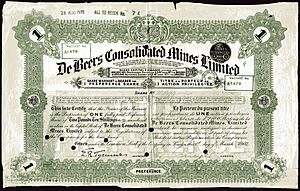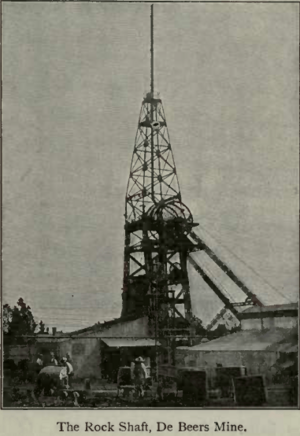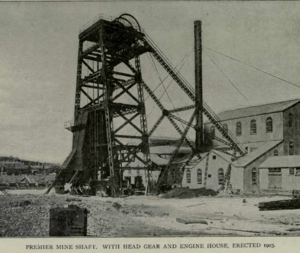De Beers facts for kids
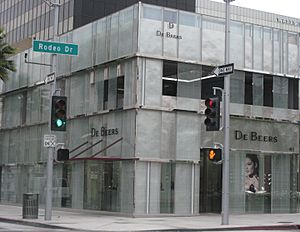
DeBeers store on Rodeo Drive in Beverly Hills, California, in 2008
|
|
| Industry | Mining and trading of diamonds |
|---|---|
| Founded | 1888 |
| Founder | Cecil Rhodes |
| Headquarters | London, England, UK |
|
Area served
|
Worldwide |
|
Key people
|
|
| Products | Diamonds |
| Brands | De Beers London, Forevermark, Lightbox, ORIGIN - De Beers Group, A Diamond is Forever, Element Six |
| Services | Diamond mining, marketing, grading and jewellery |
| Revenue | |
| Owners |
|
|
Number of employees
|
c. 20,000 |
The De Beers Group is a company from South Africa and Britain that works with diamonds. They do many things, like finding diamonds in the ground, exploring for new diamond spots, selling diamonds in stores, and even making special diamonds for industrial use.
De Beers uses different ways to mine diamonds, including digging large open pits, underground tunnels, and even searching in rivers and along coastlines. They work in 35 countries, with mining happening in Botswana, Namibia, South Africa, and Canada. They also have a special business called Gemfair that helps small-scale diamond miners in Sierra Leone.
For a long time, from when it started in 1888 until the early 2000s, De Beers controlled most of the world's rough diamond supply. This meant they had a very strong influence over the diamond market. By 2000, their control of the world's diamond supply had become less, dropping to about 63%.
The company was started in 1888 by a British businessman named Cecil Rhodes. He received money from a South African diamond expert, Alfred Beit, and a bank in London called N M Rothschild & Sons. Later, in 1926, Ernest Oppenheimer joined the company's board. He helped De Beers become even stronger in the diamond world.
In 2011, another mining company called Anglo American bought a large part of De Beers. This meant that the Oppenheimer family, who had controlled De Beers for 80 years, no longer owned most of it. Today, Anglo American owns 85% of De Beers, and the Government of Botswana owns the other 15%.
History of De Beers
How De Beers Started
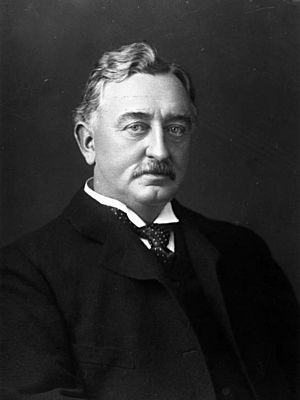
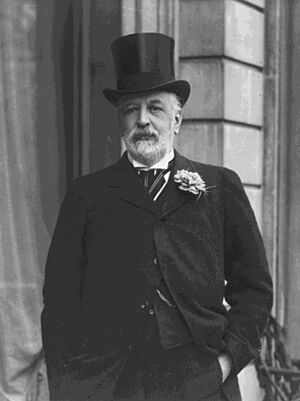
The name 'De Beers' comes from two brothers, Diederik Arnoldus de Beer and Johannes Nicolaas de Beer. They owned a farm in South Africa called Vooruitzicht, which means "prospect" or "outlook" in Dutch. Diamonds were found on their land, and they sold the farm in 1871. This farm later became the site of two very successful diamond mines, the Big Hole and the De Beers mine. The company was named after these mines.
Cecil Rhodes, who started De Beers, began by renting water pumps to diamond miners during the diamond rush that began in 1869. He used the money he earned to buy up small mining areas. Soon, his operations grew into a big mining company. He got money from the Rothschild family to help his business grow even more.
In 1888, De Beers Consolidated Mines was officially formed when Cecil Rhodes's company joined with another company owned by Barney Barnato. At this point, De Beers owned almost all the diamond mining in South Africa. In 1889, Rhodes made a deal with a group in London called the Diamond Syndicate. They agreed to buy a set amount of diamonds at a certain price. This helped control how many diamonds were sold and kept prices steady.
During the Second Boer War, which was a difficult time, the city of Kimberley (where the mines were) was surrounded. Cecil Rhodes went to Kimberley to help. He used all the company's resources to help defend the city. De Beers workshops made things like shells, defenses, and even a special gun called Long Cecil.
The Oppenheimer Family's Role
In 1898, more diamonds were found near Pretoria, leading to the discovery of the Premier Mine. This mine, later renamed the Cullinan Mine, was where the Cullinan Diamond, the largest rough diamond ever found, was discovered in 1905. The owner of the Premier Mine did not want to join De Beers. Instead, they sold diamonds to independent dealers, including Ernest Oppenheimer.
Ernest Oppenheimer believed that to keep diamonds valuable, they needed to be kept somewhat rare. He said in 1910 that "common sense tells us that the only way to increase the value of diamonds is to make them scarce, that is to reduce production."
During World War I, the Premier Mine eventually became part of De Beers. When Cecil Rhodes passed away in 1902, De Beers controlled 90% of the world's diamond production. Ernest Oppenheimer became the chairman of the company in 1929. He was worried about new diamond discoveries in German South West Africa because more diamonds could make prices go down.
In May 1955, Ernest Oppenheimer opened a new main office that brought together De Beers and another company he founded, Anglo American. After Ernest passed away in 1957, his son, Harry Oppenheimer, took over. Under Harry, De Beers grew and started operating in many different countries. Harry Oppenheimer was against apartheid in South Africa, believing it hurt the economy.
Harry Oppenheimer stepped down as chairman in December 1982.
Changes in the 21st Century
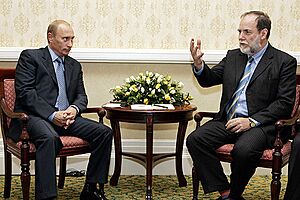
For many years, De Beers used different ways to keep its strong position in the diamond market. They tried to get other diamond producers to sell their diamonds only through De Beers. If a producer refused, De Beers might sell many similar diamonds to lower their prices. They also bought and stored diamonds to control how many were available, which helped keep prices up.
Around 2000, De Beers's business model started to change. Diamond producers in Canada and Australia began selling their diamonds outside of De Beers's system. Also, there was growing concern about "blood diamonds" (diamonds sold to fund conflicts). This made De Beers want to make sure their diamonds were conflict-free.
Because of these changes, De Beers's share of the rough diamond market went down. In 2011, the Oppenheimer family decided to sell their remaining share in De Beers to Anglo American plc. This increased Anglo American's ownership to 85%, ending the Oppenheimer family's long control of the company. The Government of Botswana owns the other 15%.
In 2020, De Beers stated that they are committed to not using forced labor in their company.
By 2025, De Beers had a large number of unsold diamonds. This was because people were buying fewer natural diamonds. Lab-grown diamonds, which are much cheaper, became very popular. In 2025, lab-grown diamonds cost about 90% less than natural diamonds, compared to only 10% less in 2018.
Marketing Diamonds
De Beers has been very successful at advertising diamonds to make people want them. One of their most famous ideas was to link diamonds with love and commitment. A writer named Frances Gerety created the famous slogan, 'A Diamond is Forever', in 1947. This slogan was later named the best advertising slogan of the 20th century. It even inspired the James Bond movie title Diamonds Are Forever.
Other successful campaigns include the 'eternity ring', which symbolizes lasting affection, and the 'trilogy ring', which represents the past, present, and future of a relationship. They also promoted the 'right hand ring' for women to buy as a symbol of their independence.
De Beers also had popular TV ads with silhouettes of people wearing diamonds, set to the music of 'Palladio' by Karl Jenkins.
In May 2018, De Beers launched a new brand called "Lightbox" that sold jewelry made with synthetic diamonds (lab-grown diamonds). These lab-grown diamonds were much cheaper than natural diamonds. However, in May 2025, De Beers announced they would stop selling the Lightbox brand. This was because it was hard to compete with the very low prices of other lab-grown diamonds.
De Beers Operations
In Botswana, De Beers mines diamonds through a company called Debswana. This company is equally owned by De Beers and the Government of Botswana. They operate four mines: Jwaneng, Orapa, Letlhakane, and Damtshaa.
In Namibia, De Beers mines diamonds with Namdeb Holdings, which is also equally owned by De Beers and the Government of Namibia. This includes mining on land and offshore (in the ocean). For offshore mining, they use large ships like the SS Nujoma and the Benguela Gem, which is the world's largest diamond vessel.
De Beers Consolidated Mines handles the mining in South Africa. De Beers owns 74% of this company. They have two mines there: Venetia and Voorspoed.
De Beers also has mines in Canada. They opened the Snap Lake Diamond Mine in 2008, which was their first mine outside Africa and Canada's first completely underground diamond mine. They also opened the Victor Diamond Mine in Ontario and the Gahcho Kue Diamond Mine in 2016.
De Beers sells rough diamonds in two main ways: through De Beers Global Sightholder Sales (GSS) and De Beers Auction Sales. GSS sells about 90% of their rough diamonds. They sort, value, and sell a large portion of the world's rough diamonds. Their customers are called Sightholders, who have long-term contracts, and Accredited Buyers, who can buy diamonds not sold to Sightholders. De Beers also sells about 10% of its rough diamonds through online auctions.
De Beers employs more than 30,000 people around the world. A large number of these employees are in Africa, especially in Botswana, South Africa, and Namibia.
In February 2020, De Beers reported lower earnings, their lowest since Anglo American bought the company in 2012.
Company Structure and Brands
On November 4, 2011, Anglo American plc increased its ownership in De Beers to 85%. The Government of the Republic of Botswana owns the remaining 15%. De Beers plc is the main company that oversees all the different parts of the De Beers Group. They are involved in every step of the diamond process, from mining to selling.
De Beers works through several joint ventures (companies they own with other partners):
- Debmarine Namibia
- Debswana
- DTCB
- Namdeb
- NDTC
They also have companies they fully own in southern Africa and Canada. Other fully owned brands include Forevermark, De Beers Jewellers, and Element Six (which makes industrial diamonds).
Forevermark Diamonds
Forevermark is a diamond brand launched by De Beers in 2008. Each Forevermark diamond has a tiny, invisible inscription that promises it is beautiful, rare, and sourced responsibly. This inscription helps identify Forevermark diamonds. Only a very small percentage of the world's diamonds are chosen to be Forevermark diamonds.
De Beers London Jewelry
De Beers Diamond Jewellers (DBDJ) started in 2001 as a partnership between De Beers and LVMH, a French luxury company. Their first store opened in London in 2002. In March 2017, De Beers Group bought LVMH's share, and the company was renamed De Beers Jewellers. In 2025, De Beers Jewellers was rebranded as De Beers London.
Institute of Diamonds The International Institute of Diamond Grading & Research (IIDGR) was created by De Beers in 2008. It helps check and verify diamonds. It works only with diamonds that follow the rules of the United Nations' World Diamond Council Kimberley Process.
ORIGIN - De Beers Group
Origin - De Beers Group is a brand for polished diamonds that are sold in other jewelry stores, not just De Beers's own stores.
Diamonds and the Kimberley Process
In 1999, a group called Global Witness brought attention to how some diamonds were being used to fund conflicts, known as "blood diamonds." This led to a review by the United Nations.
To help stop the trade of conflict diamonds, De Beers Group stopped buying diamonds from outside sources in 2000. This was to make sure all their diamonds were conflict-free.
In 2002, governments, the diamond industry (led by De Beers), and other groups worked together to create the Kimberley Process Certification Scheme (KPCS). This plan sets rules for controlling the trade of rough diamonds and started in 2003.
De Beers states that all the diamonds they sell are conflict-free and follow the Kimberley Process rules. This process has helped improve the diamond industry's reputation.
In 2018, De Beers started using a special technology called blockchain to track 100 valuable diamonds. This helped them follow the diamonds from the mine to the store to ensure their quality and that they were conflict-free. In 2019, they launched their own tracking system called Tracr, which allows all diamonds to be traced from the mine to the store.
Working with Communities
In August 2017, De Beers teamed up with the Stanford Graduate School of Business to help new businesses grow in Botswana, Namibia, and South Africa. This partnership helps teach young business owners how to develop their ideas.
In September 2017, De Beers partnered with UN Women to help women advance within the company and in the countries where De Beers operates. In 2018, they started a program to support 500 women who run small businesses in communities near De Beers's Venetia diamond mine.
|
See also
 In Spanish: De Beers para niños
In Spanish: De Beers para niños
- Blood diamond
- Canadian diamonds
- De Beers Diamond Oval
- List of diamonds
- Synthetic diamond


